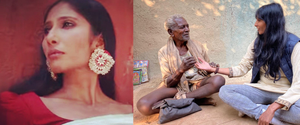New Delhi: A milkman in a small village in the interiors of Panna, Madhya Pradesh would be suddenly possessed by the spirit of ‘Thakur Baba’, gaining miraculous powers to heal those who truly believed.
In a rare case, a woman Shaman belonging to the Santhal tribe would go into trance and start answering questions, and prescribing ways to heal to those who came to her.
After all, the power of belief can transcend everything else.
There are many more instances that Parvati T, an enthusiast of self-healing practices, witnessed among different tribes across the country — first with awe, then with gratitude.
She has recorded them in her yet-to-be-released book ‘Wellness Secrets of India’s Tribes’, a project sanctioned by the Ministry of Tribal Affairs and supported by the Tata Steel Foundation.
Her long journey into holistic coaching and therapy (‘SoulSatya’) led to the creation of a book complete with extensive images.
During her research, Parvati, along with another researcher and photographer, travelled extensively exposing herself to the rich and diverse cultural heritage of several tribal communities.
In Madhya Pradesh, they visited the Gond, Kwandar, and Pardhi tribes, each with their unique healing practices and traditional knowledge.
In Uttarakhand, she connected with the Jaunsari and Bhutia tribes, learning about their herbal remedies and spiritual healing rituals.
West Bengal introduced her to the Santhal and Murmu tribes, whose deep understanding of nature’s healing powers left a lasting impression on her.
In Jharkhand, they spent time with the Munda, Bhil, and Baiga tribes, witnessing their profound respect for the environment and their unique medicinal practices. Additionally, the book features insights from other tribes, each contributing to the rich mixture of India’s indigenous healing wisdom.
She said, “The tribals welcomed us into their homes and lives, showing us a level of personal care and respect that was truly heartwarming. As a woman, I was particularly moved by the respect and consideration they extended to me.”
“In exploring these traditional tribal communities, I have glimpsed into the way we once were – our roots, values, and the simple yet profound way of life that characterised our past. However, these traditions are changing rapidly, influenced by the relentless march of ‘modernity’.”
She feels the transformation threatens to erode the rich cultural diversity that these communities embody, and that it is important to make concerted efforts to support and preserve traditional practices and these communities before they are lost forever.
While ‘vaids’ (traditional healers) may be fast disappearing from the urban landscape, their position remains intact among tribals.
“They have an intricate understanding of the medicinal properties of plants. Their knowledge is vast, stemming from generations of passed-down wisdom. For them, every plant holds a healing property, and it is merely a matter of knowing how to harness it,” she asserted.
“To me, it became clear that while modern medicine offers many solutions, the ancient traditions of healing provide a holistic approach that incorporates the mind, body, and spirit. This belief-driven healing, whether through the spiritual power of a local healer or the botanical expertise of a ‘Vaid’, demonstrates the enduring power of traditional practices and the profound impact they can have on individuals and communities alike.”
While for years, tribes in India and around the world have been healing with plant medicine, ‘mantras’ to even supernatural practices, some of which are considered far-fetched, Parvati, also a columnist and communications professional, believes that at the end of the day, these traditional practices have stood the test of time and the tribal communities, and outsiders like her still go to them for cures when they are at sea.
“There is a certain enigma in their healing practices, and that is why I was drawn to research on the wellness secrets of India’s tribes.”
Planning to continue her research into alternative and traditional forms of healing, she wants to build awareness of tribal knowledge and other forms of natural and self-healing techniques, which are still relevant and have many takers in contemporary times.
–IANS


Comments are closed.